engine Abarth 500 2020 Owner handbook (in English)
[x] Cancel search | Manufacturer: ABARTH, Model Year: 2020, Model line: 500, Model: Abarth 500 2020Pages: 196, PDF Size: 3.53 MB
Page 123 of 196
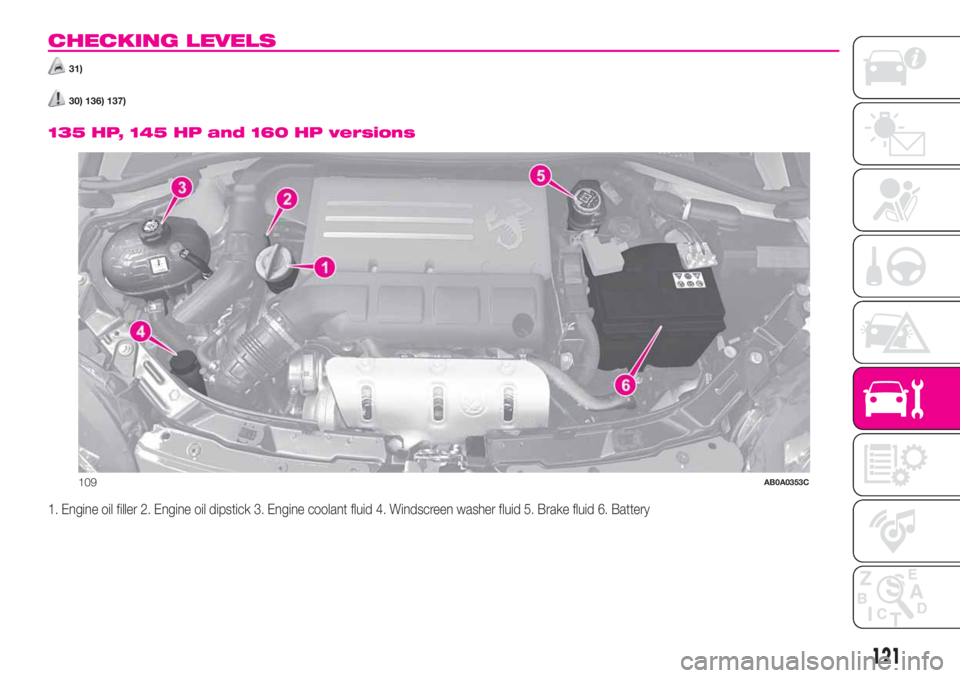
CHECKING LEVELS
31)
30) 136) 137).
135 HP, 145 HP and 160 HP versions
1. Engine oil filler 2. Engine oil dipstick 3. Engine coolant fluid 4. Windscreen washer fluid 5. Brake fluid 6. Battery
109AB0A0353C
121
Page 124 of 196
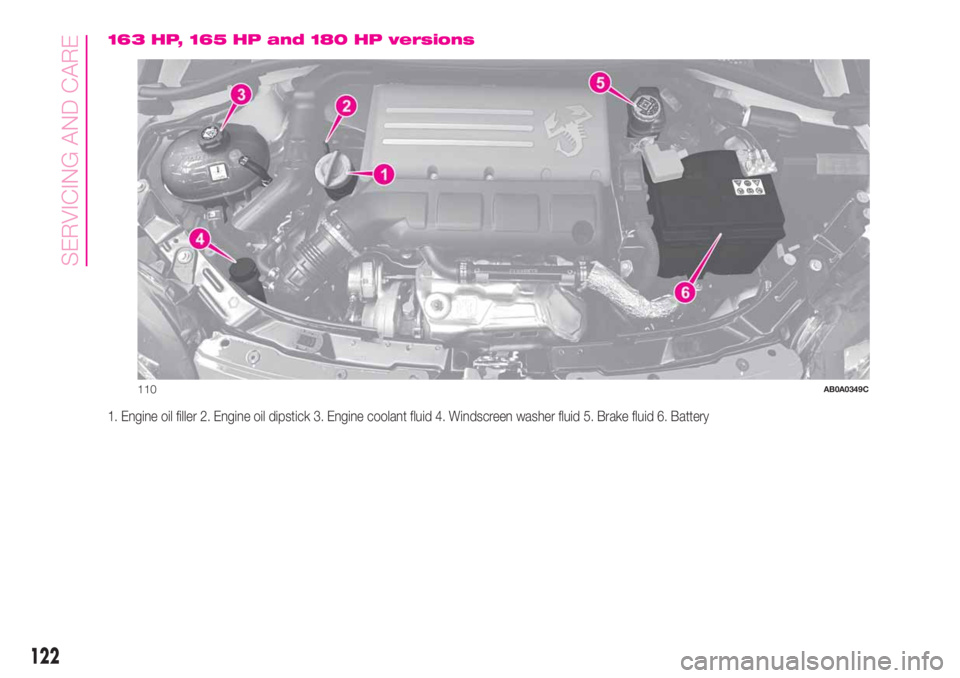
163 HP, 165 HP and 180 HP versions
1. Engine oil filler 2. Engine oil dipstick 3. Engine coolant fluid 4. Windscreen washer fluid 5. Brake fluid 6. Battery
110AB0A0349C
122
SERVICING AND CARE
Page 125 of 196
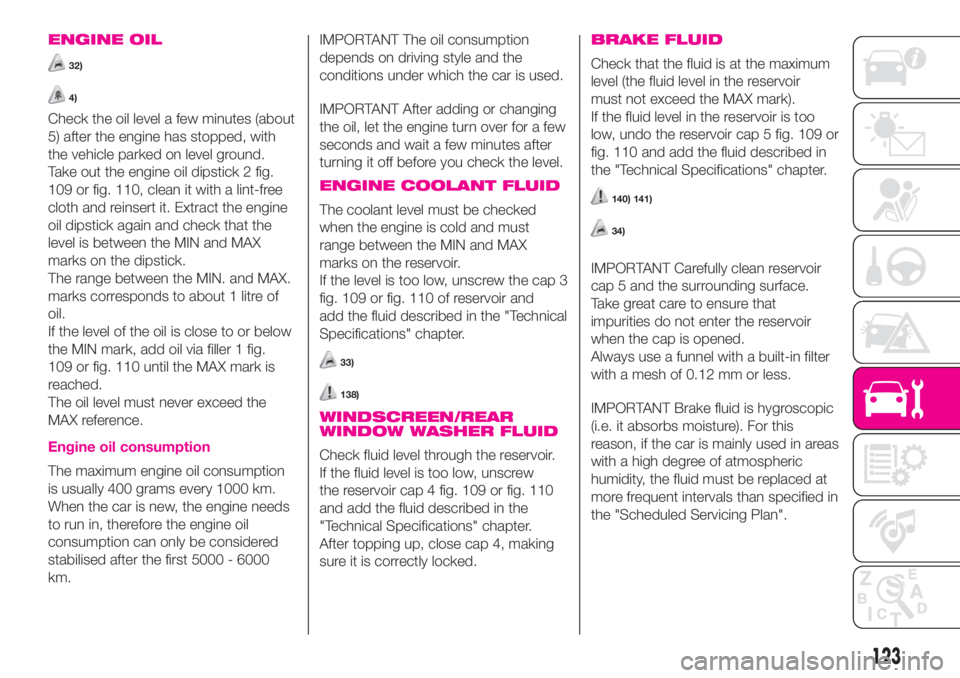
ENGINE OIL
32)
4)
Check the oil level a few minutes (about
5) after the engine has stopped, with
the vehicle parked on level ground.
Take out the engine oil dipstick 2 fig.
109 or fig. 110, clean it with a lint-free
cloth and reinsert it. Extract the engine
oil dipstick again and check that the
level is between the MIN and MAX
marks on the dipstick.
The range between the MIN. and MAX.
marks corresponds to about 1 litre of
oil.
If the level of the oil is close to or below
the MIN mark, add oil via filler 1 fig.
109 or fig. 110 until the MAX mark is
reached.
The oil level must never exceed the
MAX reference.
Engine oil consumption
The maximum engine oil consumption
is usually 400 grams every 1000 km.
When the car is new, the engine needs
to run in, therefore the engine oil
consumption can only be considered
stabilised after the first 5000 - 6000
km.IMPORTANT The oil consumption
depends on driving style and the
conditions under which the car is used.
IMPORTANT After adding or changing
the oil, let the engine turn over for a few
seconds and wait a few minutes after
turning it off before you check the level.
ENGINE COOLANT FLUID
The coolant level must be checked
when the engine is cold and must
range between the MIN and MAX
marks on the reservoir.
If the level is too low, unscrew the cap 3
fig. 109 or fig. 110 of reservoir and
add the fluid described in the "Technical
Specifications" chapter.
33)
138)
WINDSCREEN/REAR
WINDOW WASHER FLUID
Check fluid level through the reservoir.
If the fluid level is too low, unscrew
the reservoir cap 4 fig. 109 or fig. 110
and add the fluid described in the
"Technical Specifications" chapter.
After topping up, close cap 4, making
sure it is correctly locked.
BRAKE FLUID
Check that the fluid is at the maximum
level (the fluid level in the reservoir
must not exceed the MAX mark).
If the fluid level in the reservoir is too
low, undo the reservoir cap 5 fig. 109 or
fig. 110 and add the fluid described in
the "Technical Specifications" chapter.
140) 141)
34)
IMPORTANT Carefully clean reservoir
cap 5 and the surrounding surface.
Take great care to ensure that
impurities do not enter the reservoir
when the cap is opened.
Always use a funnel with a built-in filter
with a mesh of 0.12 mm or less.
IMPORTANT Brake fluid is hygroscopic
(i.e. it absorbs moisture). For this
reason, if the car is mainly used in areas
with a high degree of atmospheric
humidity, the fluid must be replaced at
more frequent intervals than specified in
the "Scheduled Servicing Plan".
123
Page 126 of 196
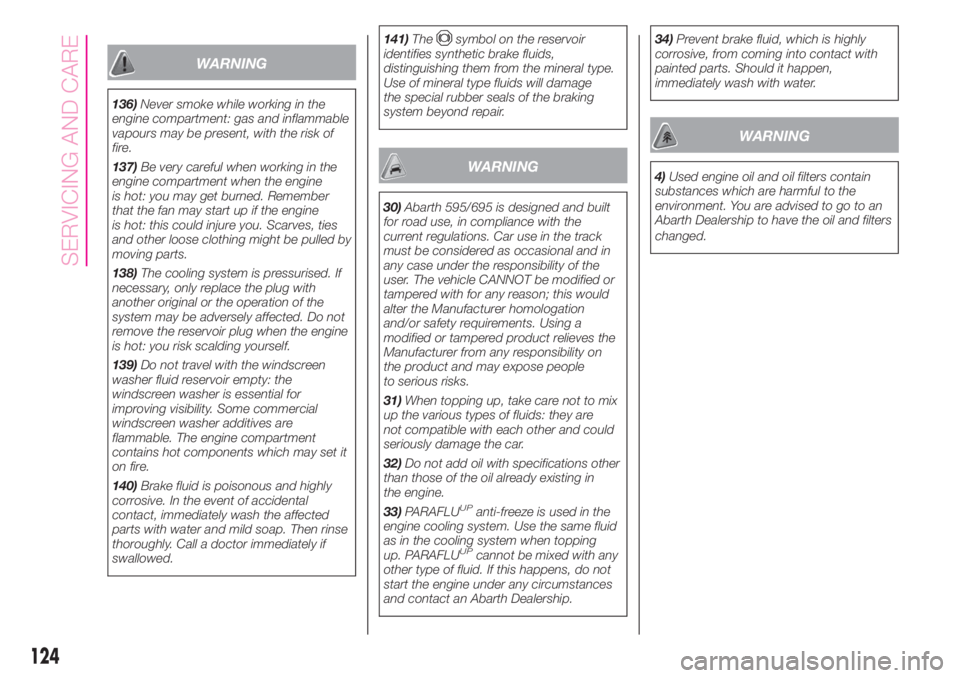
WARNING
136)Never smoke while working in the
engine compartment: gas and inflammable
vapours may be present, with the risk of
fire.
137)Be very careful when working in the
engine compartment when the engine
is hot: you may get burned. Remember
that the fan may start up if the engine
is hot: this could injure you. Scarves, ties
and other loose clothing might be pulled by
moving parts.
138)The cooling system is pressurised. If
necessary, only replace the plug with
another original or the operation of the
system may be adversely affected. Do not
remove the reservoir plug when the engine
is hot: you risk scalding yourself.
139)Do not travel with the windscreen
washer fluid reservoir empty: the
windscreen washer is essential for
improving visibility. Some commercial
windscreen washer additives are
flammable. The engine compartment
contains hot components which may set it
on fire.
140)Brake fluid is poisonous and highly
corrosive. In the event of accidental
contact, immediately wash the affected
parts with water and mild soap. Then rinse
thoroughly. Call a doctor immediately if
swallowed.141)The
symbol on the reservoir
identifies synthetic brake fluids,
distinguishing them from the mineral type.
Use of mineral type fluids will damage
the special rubber seals of the braking
system beyond repair.
WARNING
30)Abarth 595/695 is designed and built
for road use, in compliance with the
current regulations. Car use in the track
must be considered as occasional and in
any case under the responsibility of the
user. The vehicle CANNOT be modified or
tampered with for any reason; this would
alter the Manufacturer homologation
and/or safety requirements. Using a
modified or tampered product relieves the
Manufacturer from any responsibility on
the product and may expose people
to serious risks.
31)When topping up, take care not to mix
up the various types of fluids: they are
not compatible with each other and could
seriously damage the car.
32)Do not add oil with specifications other
than those of the oil already existing in
the engine.
33)PARAFLU
UPanti-freeze is used in the
engine cooling system. Use the same fluid
as in the cooling system when topping
up. PARAFLU
UPcannot be mixed with any
other type of fluid. If this happens, do not
start the engine under any circumstances
and contact an Abarth Dealership.34)Prevent brake fluid, which is highly
corrosive, from coming into contact with
painted parts. Should it happen,
immediately wash with water.
WARNING
4)Used engine oil and oil filters contain
substances which are harmful to the
environment. You are advised to go to an
Abarth Dealership to have the oil and filters
changed.
124
SERVICING AND CARE
Page 127 of 196
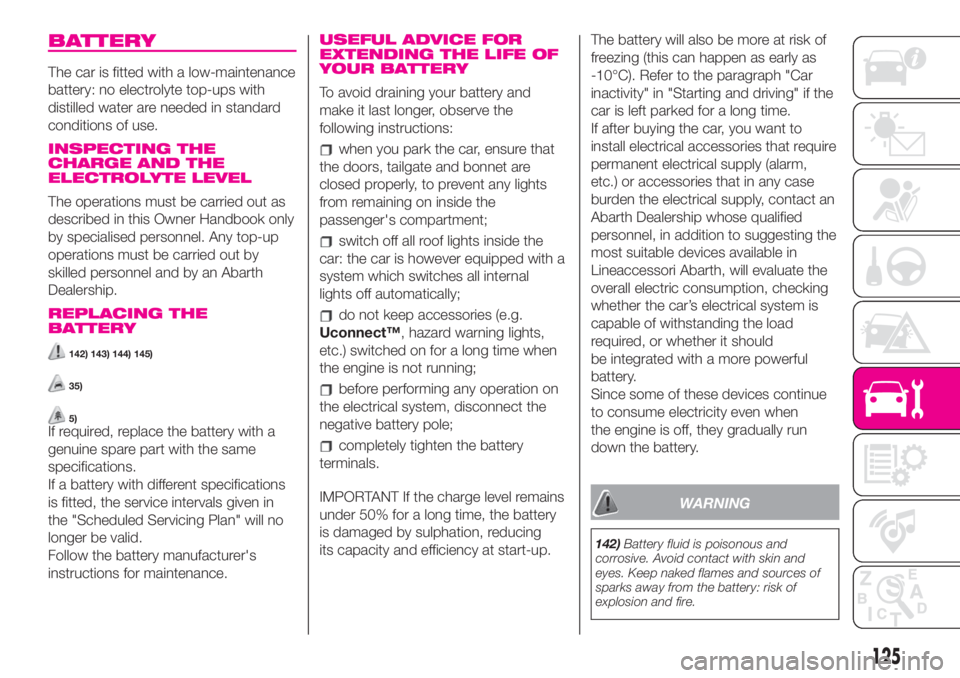
BATTERY
The car is fitted with a low-maintenance
battery: no electrolyte top-ups with
distilled water are needed in standard
conditions of use.
INSPECTING THE
CHARGE AND THE
ELECTROLYTE LEVEL
The operations must be carried out as
described in this Owner Handbook only
by specialised personnel. Any top-up
operations must be carried out by
skilled personnel and by an Abarth
Dealership.
REPLACING THE
BATTERY
142) 143) 144) 145)
35)
5)If required, replace the battery with a
genuine spare part with the same
specifications.
If a battery with different specifications
is fitted, the service intervals given in
the "Scheduled Servicing Plan" will no
longer be valid.
Follow the battery manufacturer's
instructions for maintenance.
USEFUL ADVICE FOR
EXTENDING THE LIFE OF
YOUR BATTERY
To avoid draining your battery and
make it last longer, observe the
following instructions:
when you park the car, ensure that
the doors, tailgate and bonnet are
closed properly, to prevent any lights
from remaining on inside the
passenger's compartment;
switch off all roof lights inside the
car: the car is however equipped with a
system which switches all internal
lights off automatically;
do not keep accessories (e.g.
Uconnect™, hazard warning lights,
etc.) switched on for a long time when
the engine is not running;
before performing any operation on
the electrical system, disconnect the
negative battery pole;
completely tighten the battery
terminals.
IMPORTANT If the charge level remains
under 50% for a long time, the battery
is damaged by sulphation, reducing
its capacity and efficiency at start-up.The battery will also be more at risk of
freezing (this can happen as early as
-10°C). Refer to the paragraph "Car
inactivity" in "Starting and driving" if the
car is left parked for a long time.
If after buying the car, you want to
install electrical accessories that require
permanent electrical supply (alarm,
etc.) or accessories that in any case
burden the electrical supply, contact an
Abarth Dealership whose qualified
personnel, in addition to suggesting the
most suitable devices available in
Lineaccessori Abarth, will evaluate the
overall electric consumption, checking
whether the car’s electrical system is
capable of withstanding the load
required, or whether it should
be integrated with a more powerful
battery.
Since some of these devices continue
to consume electricity even when
the engine is off, they gradually run
down the battery.
WARNING
142)Battery fluid is poisonous and
corrosive. Avoid contact with skin and
eyes. Keep naked flames and sources of
sparks away from the battery: risk of
explosion and fire.
125
Page 132 of 196

Do not wash the car after it has been
left in the sun or with the bonnet hot:
this may alter the shine of the
paintwork.
Exterior plastic parts must be cleaned
in the same way as the rest of the
vehicle.
Where possible, do not park under
trees; the resinous substances that
many species release give the paint a
dull appearance and increase the
possibility of triggering rusting
processes.
IMPORTANT Bird droppings must be
washed off immediately and thoroughly
as the acid they contain is particularly
aggressive.
6)
38)
Versions with matt paintwork
These versions have exclusive matt
paintwork which requires special care
for its preservation. The instructions for
good preservation follow below.
38) 39) 40)
Versions with stickers
Cars that are wholly or partially
covered, decorated and/or customised
with stickers, must only be cleaned
by hand.
The use of solvents, waxes, detergents
or similar products is not recommended
for the care of the car as they could
damage the stickers or cause them to
detach.
The use of such washing or cleaning
instruments and methods will therefore
invalidate the warranty.
NOTE We recommend using mild
products for cleaning the car.
IMPORTANT In case of stains (water
rings) on the wrapping, remove them by
washing the wrapping again and drying
it with a non-abrasive soft cloth.
38) 39) 40) 41)
Windows
To clean glasses, use specific cleaning
products.
Use clean cloths to avoid scratching
the glass or altering the transparency.
IMPORTANT Wipe the rear window
inside gently with a cloth following the
direction of the filaments to avoid
damaging the heating device.
42)
Front headlights
Use a soft cloth soaked in water and
detergent for washing cars.
IMPORTANT Never use aromatic
substances (e.g. petrol) or ketones (e.g.
acetone) for cleaning the plastic lenses
of the headlights.
IMPORTANT When cleaning with a
pressure washer, keep the water jet at
least 20 cm away from the headlights.
Engine compartment
Wash the engine compartment
thoroughly at the end of every winter.
Be careful not to direct the jet of water
onto electronic control units.
Adequately protect the upper air
intakes to prevent damage to the
windscreen wiper motor. Have this
operation performed at a specialised
workshop.
IMPORTANT The washing should take
place with the engine cold and the
ignition key in the STOP position. After
the washing operation, make sure
that the various protections (e.g. rubber
caps and guards) have not been
removed or damaged.
130
SERVICING AND CARE
Page 136 of 196
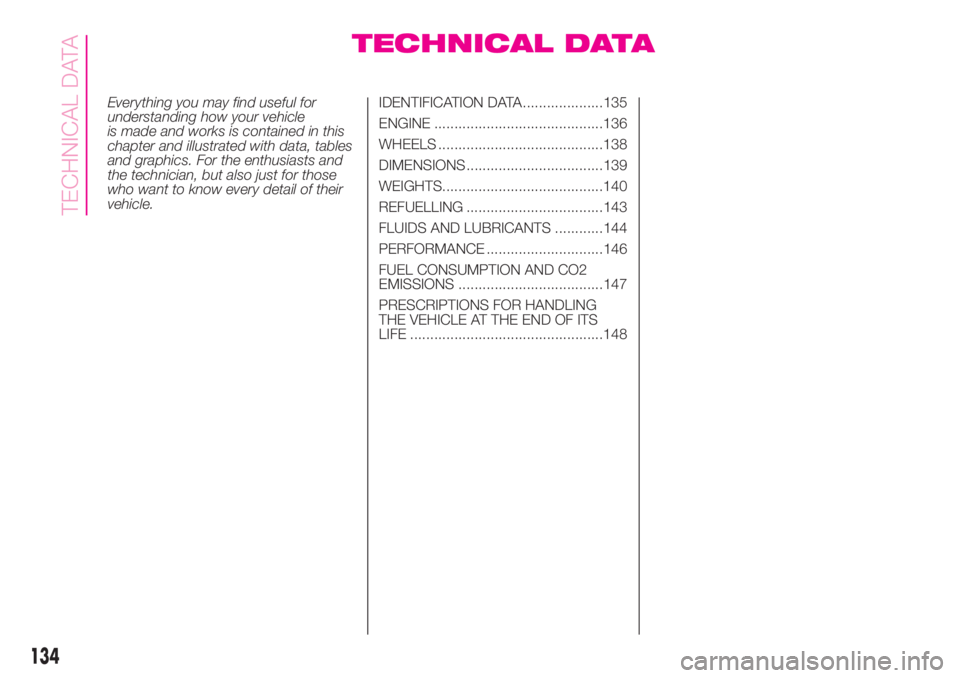
TECHNICAL DATA
Everything you may find useful for
understanding how your vehicle
is made and works is contained in this
chapter and illustrated with data, tables
and graphics. For the enthusiasts and
the technician, but also just for those
who want to know every detail of their
vehicle.IDENTIFICATION DATA....................135
ENGINE ..........................................136
WHEELS .........................................138
DIMENSIONS ..................................139
WEIGHTS........................................140
REFUELLING ..................................143
FLUIDS AND LUBRICANTS ............144
PERFORMANCE .............................146
FUEL CONSUMPTION AND CO2
EMISSIONS ....................................147
PRESCRIPTIONS FOR HANDLING
THE VEHICLE AT THE END OF ITS
LIFE ................................................148
134
TECHNICAL DATA
Page 137 of 196
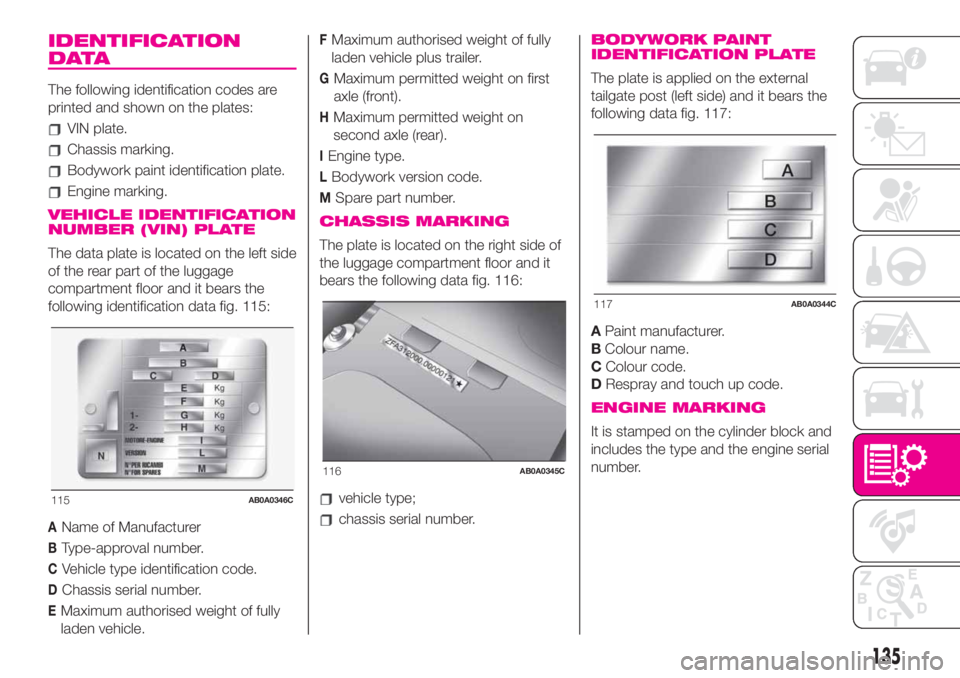
IDENTIFICATION
DATA
The following identification codes are
printed and shown on the plates:
VIN plate.
Chassis marking.
Bodywork paint identification plate.
Engine marking.
VEHICLE IDENTIFICATION
NUMBER (VIN) PLATE
The data plate is located on the left side
of the rear part of the luggage
compartment floor and it bears the
following identification data fig. 115:
AName of Manufacturer
BType-approval number.
CVehicle type identification code.
DChassis serial number.
EMaximum authorised weight of fully
laden vehicle.
FMaximum authorised weight of fully
laden vehicle plus trailer.
GMaximum permitted weight on first
axle (front).
HMaximum permitted weight on
second axle (rear).
IEngine type.
LBodywork version code.
MSpare part number.
CHASSIS MARKING
The plate is located on the right side of
the luggage compartment floor and it
bears the following data fig. 116:
vehicle type;
chassis serial number.
BODYWORK PAINT
IDENTIFICATION PLATE
The plate is applied on the external
tailgate post (left side) and it bears the
following data fig. 117:
APaint manufacturer.
BColour name.
CColour code.
DRespray and touch up code.
ENGINE MARKING
It is stamped on the cylinder block and
includes the type and the engine serial
number.
115AB0A0346C
116AB0A0345C
117AB0A0344C
135
Page 138 of 196

ENGINE
(For markets where provided)
GENERAL INFORMATION1.4 TB PETROL ABARTH 135
HP1.4 TB PETROL ABARTH 145
HP1.4 TB PETROL ABARTH 160
HP
Engine code 312A1000 312B4000 312B4000
Cycle Otto Otto Otto
Number and position of cylinders 4 in line 4 in line 4 in line
Piston bore and stroke (mm) 72 × 84 72 × 84 72 × 84
Total displacement (cm
3) 1368 1368 1368
Compression ratio 9.8 : 1 9.8 : 1 9.8 : 1
Maximum power (EC) (kW) 99 107 118
Maximum power (EEC) (HP) 135 145 160
corresponding engine speed
(rpm)5500 5500 5500
Maximum torque (EEC) (Nm)
180
(**)/ 206(***)180(**)/ 210(***)210(**)/ 230(***)
corresponding engine speed
(rpm)2000
2000(**)/ 3000(***)2000(**)/ 3000(***)
Spark plugs NGK IKR9F8 NGK IKR9F8 NGK IKR9F8
FuelUnleaded petrol 95 RON (EN 228
specification)Unleaded petrol 95 RON or 98
RON (Specification EN 228)Unleaded petrol 95 RON or 98
RON (Specification EN 228)
(**) NORMAL
(***) SPORT
136
TECHNICAL DATA
Page 139 of 196

GENERAL
INFORMATION1.4 TB PETROL
ABARTH 163 HP1.4 TB PETROL
ABARTH 165 HP1.4 TB PETROL
ABARTH 180 HP(*)1.4 TB PETROL
ABARTH 180 HP
Engine code 312B6000 312B3000 312B3000 312A3000
Cycle Otto Otto Otto Otto
Number and position of
cylinders4 in line 4 in line 4 in line 4 in line
Piston bore and stroke
(mm)72×84 72×84 72×84 72×84
Total displacement (cm
3) 1368 1368 1368 1368
Compression ratio 9.0 : 1 9.0 : 1 9.0 : 1 9.0 : 1
Maximum power (EC)
(kW)120
(****)121(****)132(****)132(****)
Maximum power (EEC)
(HP)163(****)165(****)180(****)180(****)
corresponding engine
speed (rpm)5500 5500 5500 5500
Maximum torque (EEC)
(Nm)210
(**)/ 230(***)210(**)/ 230(***)230(**)/ 250(***)230(**)/ 250(***)
corresponding engine
speed (rpm)2000(**)/ 3000(***)2000(**)/ 3000(***)2000(**)/ 3000(***)2000(**)/ 3000(***)
Spark plugs NGK IKR9F8 NGK IKR9F8 NGK IKR9F8 NGK IKR9F8
FuelUnleaded petrol 95 RON
or 98 RON (Specification
EN 228)Unleaded petrol 95 RON
or 98 RON (Specification
EN 228)Unleaded petrol 95 RON
or 98 RON (Specification
EN 228)Unleaded petrol 95 RON
or 98 RON (Specification
EN 228)
(*) Kit (for versions/markets, where provided)
(****) Result obtained using 98 RON unleaded petrol
(**) NORMAL
(***) SPORT
137